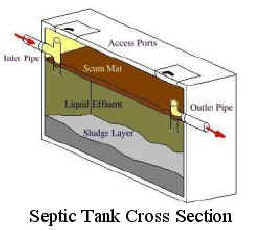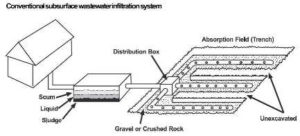Sewer Testing
If not properly maintained, an on-site septic system could cost you thousands to repair or replace. The following provides technical information and tips to help you avoid such an expense.
Septic Tanks
All on-site septic systems have a septic tank, a large container that is buried underground and is made of concrete, fiberglass or polyethylene. The septic tank protects the absorption ability of the subsoil by:
Removing solids from liquid. As sewage enters the septic tank, heavy solids settle at the bottom and forms sludge, which reduces the flow of sewage into the tank. While grease and other light solids rise to the surface (scum), both the sludge and scum are retained and break down while the liquid (effluent) is passed along to the drain field for absorption by the soil.
 Providing biological treatment. Bacterial activity breaks down the solids and liquids in anaerobic conditions (without oxygen), which are referred to as “septic,” the name given to the tank.
Providing biological treatment. Bacterial activity breaks down the solids and liquids in anaerobic conditions (without oxygen), which are referred to as “septic,” the name given to the tank.- Retaining scum and sludge. Scum, the mat of floating solids and grease, and sludge, the solids that build up in the bottom of the tank, are eventually compacted into a fraction of its original volume. Warm geographical regions of the country allow for a more complete breakdown of the scum and sludge than cool regions. Hence, tanks in warm climates tend to not require pumping or cleaning out as frequently as tanks in cold climates. Note that it is important to maintain a sufficient volume for solids to accumulate between pumpings and cleanings in order to avoid having the solids enter the drain field and clog the soil.
Septic tanks should provide at least 24-hour retention time or at least 750 gallons for a one or two-bedroom house; 900 gallons for a three-bedroom house; and 1,000 gallons for a four-bedroom house. 250 gallons should be added for each bedroom exceeding four.
Kitchen grease is generally detrimental to the septic tank’s operability. Small amounts of kitchen grease can enter the septic tank without damaging the system.
Signs of Trouble
- Sewer odors in the house and/or in the drinking water
- Illness, often to household visitors
- Sogginess around septic tank and absorption area
- Toilet runs sluggish
- Surfacing raw sewage
- Backup of sewage into washing machine, sinks, showers, toilets
General Prevention Techniques
Have septic tank pumped every 3-5 years depending on the size of your household and your tank size, Avoid putting harsh chemicals in tank at all times, Avoid planting trees and large plantings near septic system, Do annual inspections of your septic system, Conserve water and reduce waste into your septic system, Avoid flushing sanitary napkins, diapers, plastics or bulky items down toilets, Maintain healthy bacteria levels in your septic system by never flushing harmful substances such as paints, varnishes or any type of solvents, gasoline, bleach, pesticide, oil, grease and harsh cleaners.
Pumping Your Septic Tank
A septic tank accumulates solids or sludge which should be pumped out at least every three to five years. The frequency of pumping depends on your tank size and your family’s household size. Larger households generally require more frequent pumping preferably every one to three years. In Missouri, specific tank sizes are generally based on the number of bedrooms in the home because the number of bedrooms is an indicator of household size. The more bedrooms, the larger the septic tank.
Professional Inspection Services

The septic tank must be accessible for the evaluation for a thorough inspection. The seller is responsible for locating and uncovering the septic tank according to the standard real estate contracts. Inspection of a Septic System involves verifying performance of the septic drain system, visual inspection of the tank where an accessible lid is available, and inspection of the leach field area.
Inspection Services

CORNERSTONE PROPERTY INSPECTIONS LLC
954 N Oakwood Ave
Republic, MO 65738
Phone: (417) 209-4321
Fax: (417) 708-0774
Email: cpi@cpipros.com
